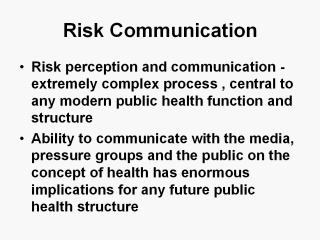 |
Public health’s ability to
communicate with the media, pressure groups and the public on the concept of
health is one that also has enormous implications for any future public
health structure and one which - whether it sits easily with training in the
specialty or not - is unlikely to disappear. Some health risks are the
result of deliberate decisions of individuals consciously trying to get the
best deal possible for themselves and those important to them, such as the
wearing of bicycle helmets and seat belts. Others involve social issues,
such as the sitting of hazardous waste incinerators, whether to vote for or
against fluoridation of public water supplies or whether to support sex
education for primary school children. In some cases, single choices can
have a large effect on individual risk - buying a car with air bags, for
example, or becoming pregnant. In others, the effects of individual choice
are small but can accumulate over multiple decisions - adding salt to food
and using butter rather than margarine. In some cases, choices tend to
affect health risks, do nothing at all, or achieve the opposite of what is
intended - for example, the adoption of quack treatments. Thus risk
perception and communication of the risks of particular behaviors,
environments and events is an extremely complex process but one that is
central to any modern public health function and structure and requires
greater attention to communication skills than has previously seemed
necessary. |
